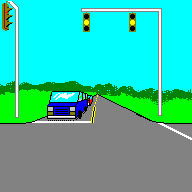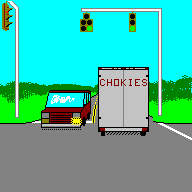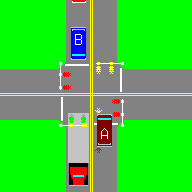CASE 1: Here is a typical case. You are "Driver A." This is what you see through your windshield. You are waiting in the intersection to turn left through a gap in oncoming traffic. The signal has just turned to circular yellow. There are several vehicles approaching in the oncoming lane. Please answer the following questions about this situation:
Question 1: What would you normally do in this case?
Answer: Usually the oncoming traffic will stop for the light. You will probably make your turn to get out of the intersection.
Question 2: What does the law say to do here?
Answer: To get out of the intersection, as your right-of-way is ending. Also, traffic not in the intersection, upon receiving a green light, must yield to vehicles already in the intersection before proceeding.
Question 3: Is it safe to turn now? Assuming that all of the traffic is obeying the law, will the oncoming traffic stop?
Answer: Normally it is safe to turn, as oncoming traffic will normally stop. We shall see what can really happen farther down.
VIEW as seen by turning driver

CASE 2: Here is another case. You are "Driver B," and see this. You are going straight ahead, following a truck through the intersection. Your following distance is the proper 2 seconds. The traffic light is circular green. The left hand signal face has 5 lights in it for a special left turn sequence, but only the circular green is lit. An oncoming van is in the intersection, waiting to turn left across your stream of traffic. Please answer the following questions about this situation:
Question 4: What would you normally do in this case?
Answer: Most drivers expect that turning traffic will yield to oncoming vehicles. You would proceed through the intersection.
Question 5: What does the law say to do here?
Answer: Left turns shall wait for a suitable gap in oncoming traffic. You should move on through the intersection so as not to block traffic.
Question 6: Is it safe to go now? Assuming that all of the traffic is obeying the law, will the oncoming van wait for you to proceed?
Answer: Normally it is safe to go, as left turning traffic will normally stop. We shall see what can really happen next.
VIEW as seen by driver going straight

CASE 3: The whole picture, from above: The first picture above is the view of Driver A, driving the maroon van seen in the second picture above. The second picture is the view of Driver B, driving the blue van seen in the first picture. Both pictures show the viewpoints of the two drivers at the same time.
The light has turned yellow in one direction to stop traffic for the left turn sequence to occur. The circular green on the other side stays on, because left turning and straight ahead traffic from the same approach can go together at the same time with all other traffic stopped. Please answer the following questions about this situation:
Question 7: What happens here?
Answer: An accident occurs (or a near miss if both drivers are very alert). Each driver expects the other driver to yield. This condition is called yellow-trap.
EACH DRIVER THINKS HE HAS THE RIGHT-OF-WAY!
Question 8: Who is at fault in this accident?
Answer: The traffic authority that allowed this signal to give conflicting indications at the same time. Several courts have ruled that this sequence "creates a virtual trap" and that both drivers could sue the traffic authority.
VIEW from above

Question 9: As a driver, what can you do to avoid yellow-trap?
Answer: The following things can be done to avoid yellow-trap:
- Do not wait in the intersection to turn left.
- Wait behind the stop line for a suitable gap in traffic.
- If you are caught in the intersection when the light turns yellow, keep waiting for a gap, or until oncoming traffic stops.
- Expect any driver waiting in an intersection to turn to suddenly dart in front of you if a left turn signal faces you.
- If the circular green is on, and the green left turn arrow lights up, expect danger if an oncoming vehicle is waiting in the intersection to turn left.
- Realize that devices other than left turn signals can create yellow-trap. Expect danger if any of these are
present:
- Sequences for unusual intersection geometry.
- Special sequences for pedestrian movements.
- Emergency vehicle pre-emption.
- Railroad pre-emption.
- Pre-emption for a drawbridge or other section of road that must be emptied quickly.
- A freeway exit ramp, stadium exit, or other place where traffic can get backed up.
- A right-turn green arrow facing the opposing approach that displays when the cross-street left-turn has a green arrow.


The yellow trap sequence:
Compare the "VIEW from above" image in the previous section with these diagrams. Note what happens. Driver A in the maroon van, turning left on a yellow light, can unwittingly collide with opposing driver B, who still has a green light.
Question 10: What can the authorities do to solve the problem?
Answer: Adopt the following rules for setting up signals:
- If a circular green allows left turns through gaps in oncoming traffic, never terminate it without also terminating the oncoming green at the same time.
- Inspect the design to make sure phase skip cannot cause separate termination of greens that allow left turns through gaps in traffic.
- Make sure that neither a defective detector nor phase recall can cause yellow-trap.
- The problem can be cured by removing the left turns through gaps in traffic, the separate termination of circular greens, or the termination of the permissive turn earlier than the opposing circular green.
- Know the vulnerable parts of each type of design.
- One approach is to terminate both circular greens simultaneously. Wait 5 seconds of all red, then show the one circular green with the turn arrow.
- Another approach is to use a flashing yellow arrow to extend the permissive left turn through the opposing lagging left turn after the thru phase changes to red.
- My own version of the flashing yellow arrow
uses standard equipment to extend the permissive left turn through the opposing lagging left turn in the same way.
It's much easier to wire and operate. It can solve most cases of yellow-trap. Also, it fixes a
perception problem that can happen on dark nights.
Here is a visual example of flashing yellow arrows.
- Yellow-trap due to phase skip normally manifests itself under light traffic conditions. Heavy traffic normally inhibits phase skipping. Inspect the actual signal installation under all possible traffic conditions.
- Check special sequences for unusual geometry, emergency vehicle pre-emption, railroad, drawbridge, queue discharge, or other special pre-emption, and special pedestrian movements, to be sure they do not terminate circular greens separately.
- Check right-turn signals, to be sure they do not terminate after circular green or flashing yellow arrows.
This is second yellow trap
Examples of left turn signals facing you:


Some traffic lights have built-in anti-yellow-trap features. Look for:
- Detector reassignment when an oncoming straight-ahead green is displayed
- Required barrier crossing instead of going backwards in the sequence
- Flashing Yellow Arrows (makes almost any sequence safe)
ANIMATION OF DOGHOUSE YELLOW TRAP

Links: